A motorist struck a pedestrian Wednesday morning in Downtown Louisville, inflicting life-threatening injuries. The collision took place around 6:00a.m. at the corner of Liberty Street and Floyd Street.
The pedestrian was a man in his 60s, according to the Louisville Metro Police Department (LMPD). Police spokesperson Dwight Mitchell added that the man was wearing dark clothing, a piece of information that should not matter but instead serves to establish victim fault. The motorist was driving a white Chevy Tahoe east on Liberty.
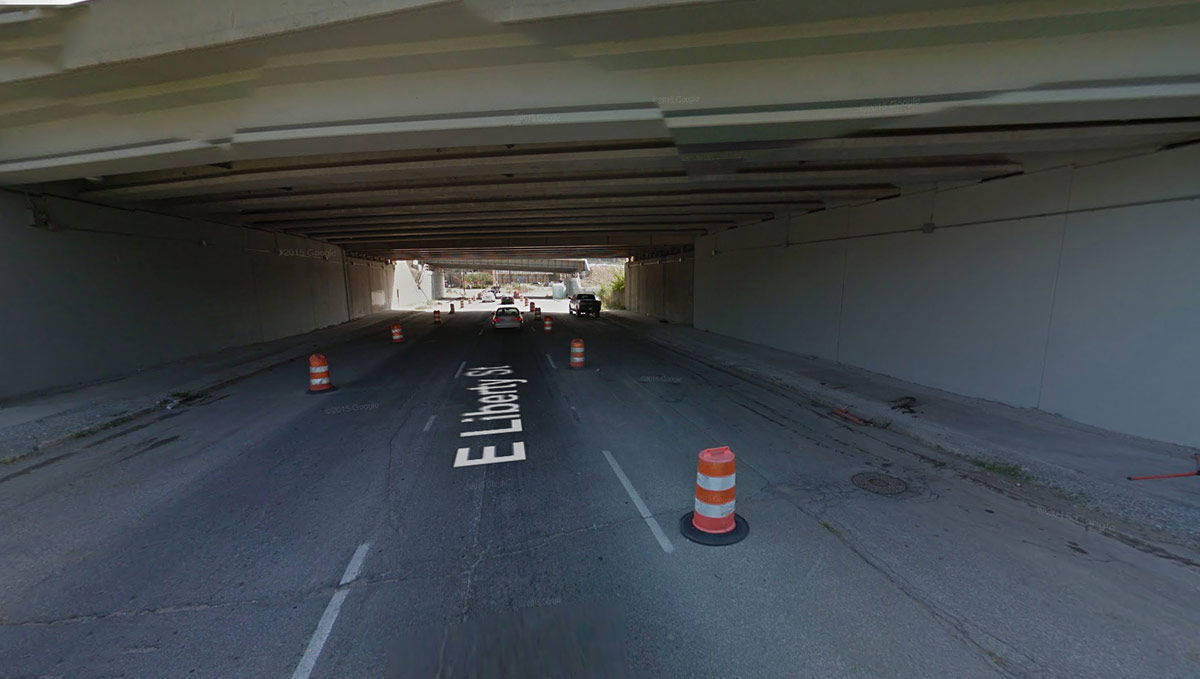
Neither the pedestrian and the motorist have been identified at this point. The victim is in critical but stable condition at University Hospital.
The collision was reported by WLKY, WDRB (which called it an accident not a crash), WHAS11 (which called it an accident not a crash), and WAVE3 (which called it an accident not a crash). We’ve already gone over the critical difference in differentiating crashes from accidents here. The way these reports are written can confuse the conversation around street safety in Louisville.
For instance, these are the intro paragraph sentences from each of those news reports, in the same order: “A pedestrian was struck Wednesday morning at Liberty Street and Interstate 65,” “A pedestrian suffered life-threatening injuries after being hit on Liberty Street early Wednesday,” “A pedestrian was hit at the intersection of E. Liberty St. and S. Floyd St.,” and “A pedestrian is in critical but stable condition after he was hit by an SUV on Floyd Street on Wednesday morning.”
None of those introductions even make mention that there was a human motorist who drove into the pedestrian. Only one of them indicates a car was involved. This type of reporting shows a motorist innocence bias, where one of the parties involved is not described as actively striking a pedestrian. One report even went as far as to note the driver remained at the scene (which is the law), furthering that bias.
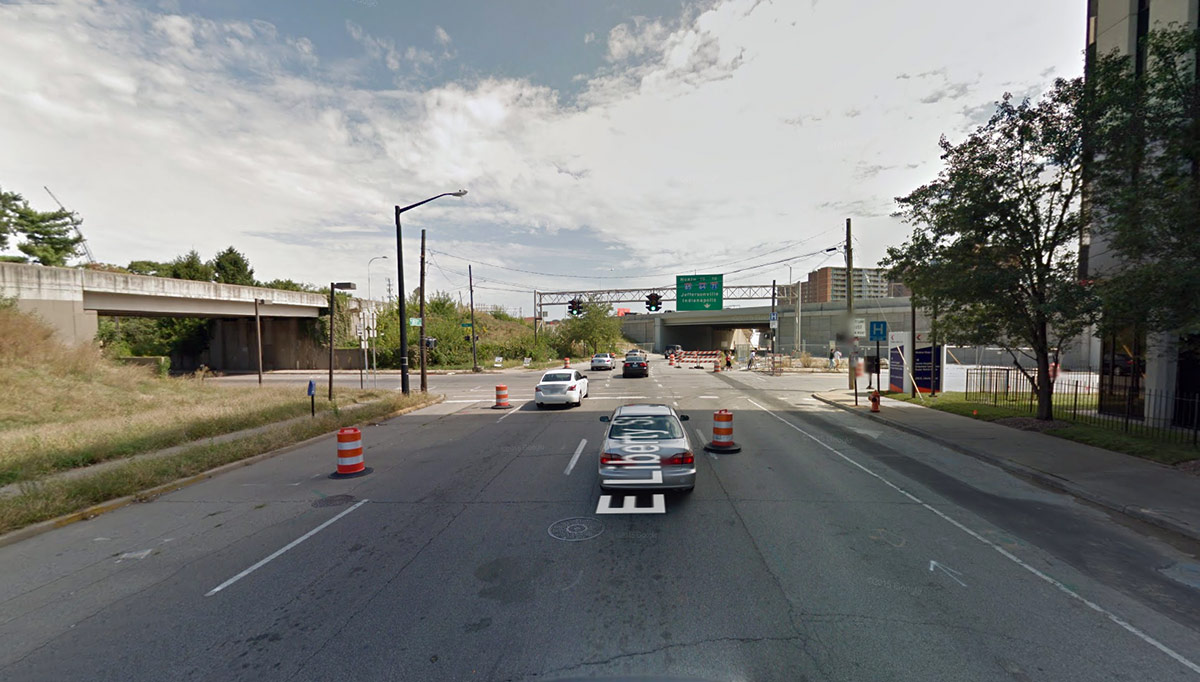
The opposite—establishing pedestrian error or fault—is also at play. Each of those reports felt it noteworthy to include the victim’s fashion choices—”dark clothing”—which doesn’t serve to advance the conversation on safety, only lay the groundwork for establishing pedestrian fault. While there are very few actual facts pertaining to the collision available, these reports have already set up scenarios where the pedestrian is to blame.
The way we repeatedly describe events can have an impact on how they’re perceived—in this case that traffic violence is a run-of-the-mill event. This is usually unintentional on the part of the writer, but paying a little more attention to the story never hurt anyone.

The average length of those reports was 94 words. Not that there’s anything wrong with brevity especially when details are scarce, but there’s more information to the story that went unreported and that obscures the traffic violence story in Louisville.
Additional information that could be helpful in understanding the problem includes the fact that Liberty Street has a speed limit of 35 mph. At this location it’s a construction zone, which would imply a need to reduce speeds. Also, Liberty Street is a five-lane, one-way superhighway that quickly is reduced to two lanes at this point for construction, which could cause confusion, especially if speed were a factor.
More information excluded from traffic violence reports: That pedestrians hit by motorists going 35 mph have a 50 percent survival rate and that the rate decreases to ten percent at 40 mph. That driving at 30–40 mph requires stopping distances of 85–145 feet. That a motorist’s peripheral vision is significantly reduced while traveling at those speeds.
If you look at the top picture from September 2015, you can see signs indicating the sidewalk on both sides of the street are closed, leaving pedestrians little recourse in moving around. On one side, they’re physically blocked, forcing pedestrians into the street to cross awkwardly midblock or turn back and walk enormous distances to get around.
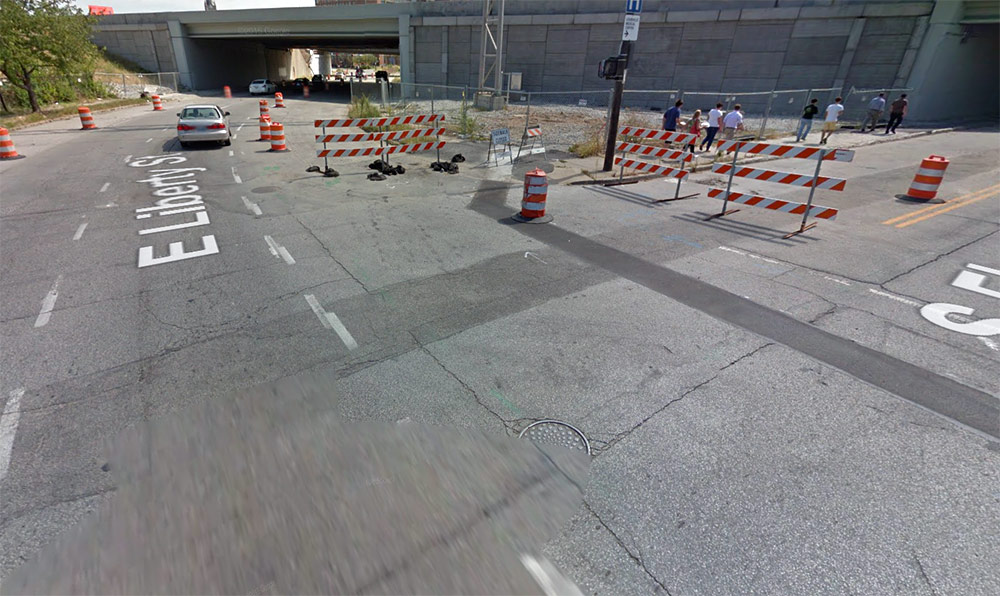
More site observations: The crosswalks at that intersection—like at many locations around Louisville—are mostly worn away and poorly visible. An enormous green sign indicating where the highway onramp is located vies for motorists attention at the intersection. That even during daytime hours, the light conditions created by such enormous highways creates lighting conditions as dark as night.
None of the reports even bothered to mention that the city is in the midst of a major three-year pedestrian safety program called Look Alive Louisville instituted because the city is among the worst in the country for pedestrian fatality rate.
With the information available in these initial reports, it’s impossible to know exactly what happened, but the framing of information, however unintentional, and the lack of other vital data on street conditions and safety information contributes to the larger problems on our streets.
We wish the victim a full and speedy recovery and hope his injuries were not in vain.


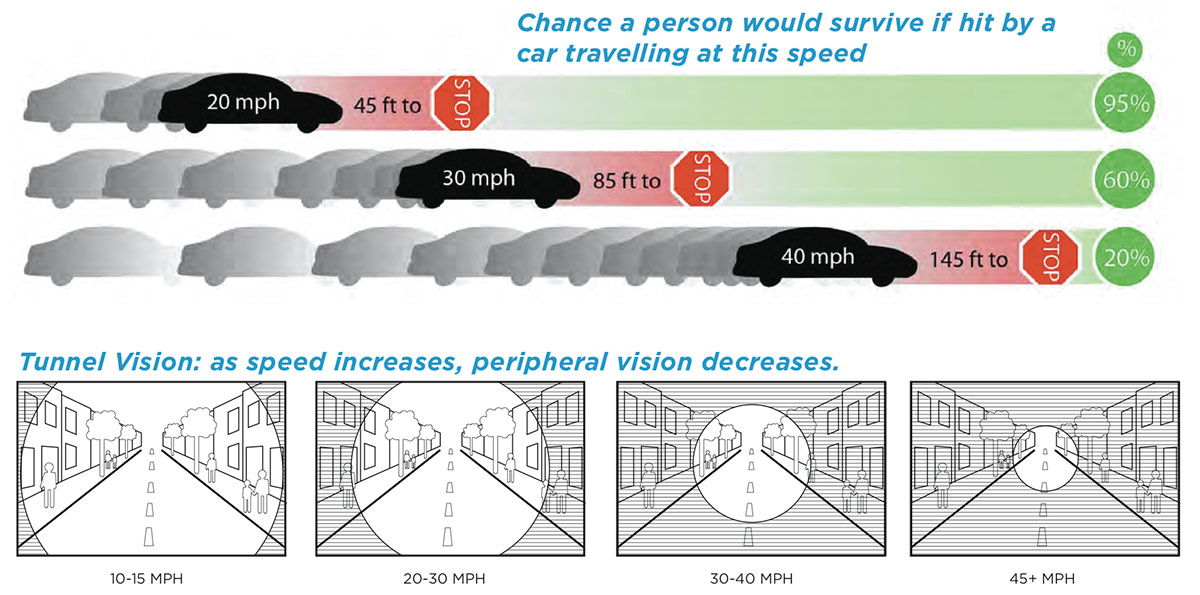
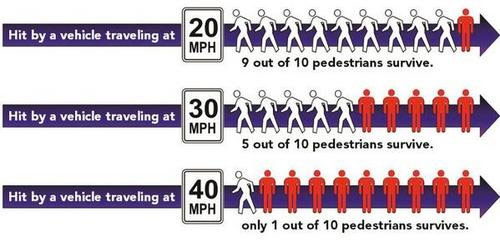

Thank you for your reporting. I am a part-time bike commuter and walk a lot as well. I have had my share of close calls with non attentive drivers. Motorists regard pedestrians and cyclists as an inconvenience, not a human being. A check of Terry Meiners’ twitter feed today includes snarky comments about the green paint marking bike lanes. How is it that cyclists and pedestrians have become the enemy?
Travel further on Liberty St. and the speed limit drops to 25 mph. It’s not well marked and drivers routinely go 40 mph. Imagine how these same drivers would feel to have someone drive thru their neighborhood streets at 40 mph! Police enforcement and heavy fines are key to changing this behavior in my opinion.
I am confused. The article starts out ” Wednesday morning……. around 6:00p.m.” Was this Wednesday morning or 6:00 p.m.?
They drive down my street at speeds exceeding 50, on a regular basis. Will there be lighting under 65 when it is completed?
Thanks for pointing that out, Jim. It’s a.m. – fixed it above.
ORBP has openly prioritized opening the new bridge faster over “nice to haves” like installing lighting under the giant blocks of new interstate or fixing and returning the sidewalks under them to a usable condition. (To the ORBP at least car convenience seems to be more important than people.)
Mike says, “Motorists regard pedestrians and cyclists as an inconvenience, not a human being.”
I’d argue that motorists don’t regard other cars/trucks as containing human beings either. It’s not as if drivers are tipping their hats to one another while running down pedestrians. It’s every man for himself. It is extremely common to see drivers blocking intersections, running lights at high speed, failing to yield, failing to signal, blocking lanes with their flashers on, trying to change lanes through heavy traffic after making a mistake. People do dumb, inconsiderate things whether they are driving cars, walking, or biking.
Be careful out there, folks.
Your article is irresponsible reporting at this point. There are not have enough facts here, yet you do what you accuse others of doing. You automatically prejudge. You assume the driver was at fault. The driver may have run a red light or may have been speeding, but we do not know that. The pedestrian could have wandered or jumped out in front of the driver, but we don’t know that either. I do know that if someone pulls out in front of you or unexpected pedestrian walks out in front of your vehicle, you might not have time time to stop. We have responsibilities as both drivers and pedestrians.
All of your points are valid, Jeff, we don’t know whether the pedestrian made some kind of error. However, I didn’t get that supposition from what Branden wrote. I understood him to be merely pointing out that the report language is inherently biased in favor of motorists (e.g. the motorist).
“Each of those reports felt it noteworthy to include the victim’s fashion choices—”dark clothing”—which doesn’t serve to advance the conversation on safety, only lay the groundwork for establishing pedestrian fault.”
I think just about anyone living in our city (our entire American society, really) — will concede that pedestrians and cyclists are designed “out” as a consideration…as a priority. Certainly, that is going to be the case during construction of something like the ORBP, but what about after this construction is completed?
So much depends upon having pedestrian and cyclists links into downtown that are as safe and welcoming as they can be is so crucial to residential redevelopment efforts on the east (and for that matter on the west and south sides, too). Since I was against this project from the start, I’m trying to remain objective, but this doesn’t look like a step in the right direction to me even as part of a phase of highway development.